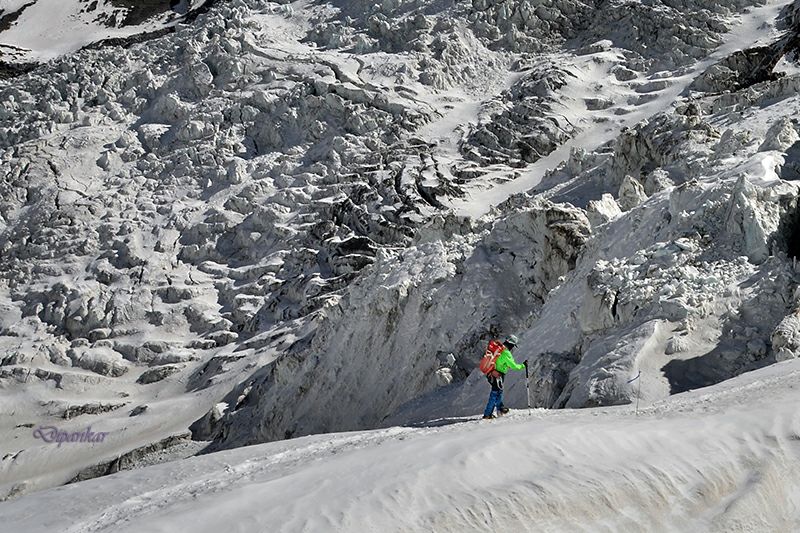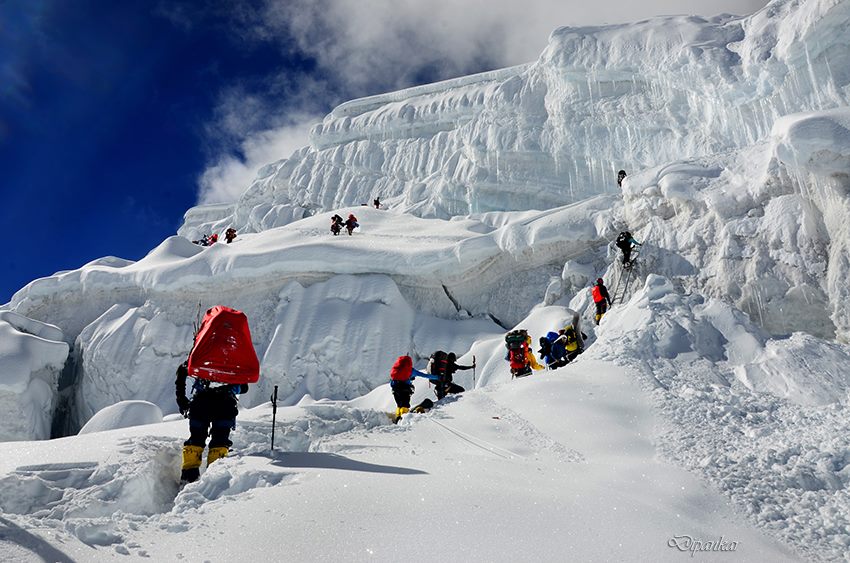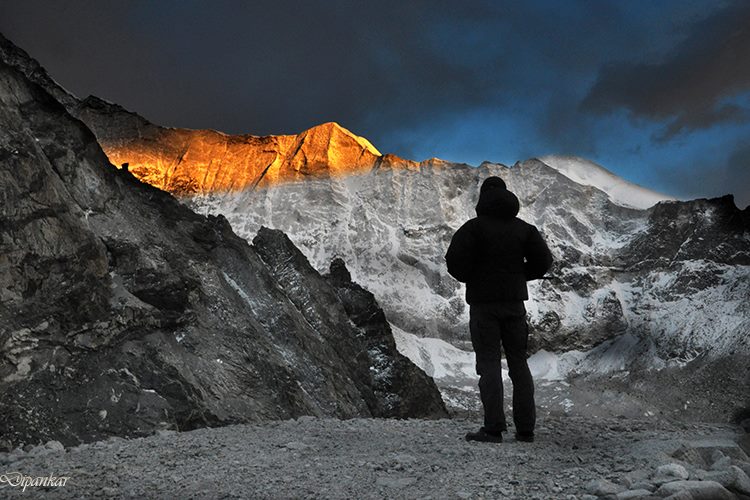There’s only one thing to do on reaching the summit – to get off the mountain as soon as possible. Dipankar Ghosh though put his life at risk to save another on Dhaulagiri in 2017. And lived to tell the tale.

First published: https://www.livemint.com/Leisure/HidyFw6z58jrxonFgNQ6ZI/A-rescue-at-8000-metres.html
A rescue at 8,000 metres
Mountaineer Dipankar Ghosh suffered a debilitating accident while summiting one of the world’s highest peaks. It changed him forever.
At 4.30pm on 28 September, Dipankar Ghosh stood atop Cho Oyu (8,201m) in the Mahalangur Himalaya on the Nepal-China border, the sixth highest mountain in the world. There was the usual sense of accomplishment after claiming his sixth 8,000er (sixth of the 14 over-8,000m mountains of the world) and as always, and in his own words, it was his zidd (persistence) that had got him there.
This time though, the feeling was more of relief than euphoria, knowing that he still had it in him to roam those lofty heights after all that he had endured.
A little over a year ago, on 20 May, Ghosh had summited Dhaulagiri (8,167m), the seventh highest mountain in the world. It had been a laborious trudge through soft snow, his progress hampered by strong winds of over 40 kmph. By the time he reached the top, it was 4.12pm—a late summit by mountaineering standards. He had to now descend 800m to get to the safety of the tents at summit camp (7,350m) before nightfall.

EARLY DAYS
Ghosh’s foray into the world of mountains began with a desire to go to places where his parents wouldn’t take him.
“They were going on the Amarnath Yatra, but told me that the journey to the cave was full of hazards. I cried and pleaded, but to no avail. When I was out of school, I finally travelled there in 1987 without informing them. Once there, I was in awe of the big mountains. And then it struck me—instead of aimlessly wandering amid them, why not get to the top of one of them?” Ghosh says, on a hazy day in Kathmandu.
Through the Bhardrakali Padatik club in Kolkata’s Uttarpara, Ghosh started out with lessons in rock climbing in the Mathabaru Hills in Purulia district—some 300km from his home in Kolkata. Even as he picked up mountaineering certifications, he began setting out on climbing expeditions in the Indian Himalaya from 1992, making as many as six first ascents over the years.

When Ghosh climbed Everest in 2011, it triggered a desire to chase other 8,000ers. But working as a salesman of computer accessories, the funds were never enough. However, he persevered, and through the support of the West Bengal government, corporates and a few like-minded friends, he would collect enough money to go on climbs, before returning to his modest lifestyle. Over the next five years, he would summit Lhotse (2012), Kanchenjunga (2014), Manaslu (2016), and make unsuccessful attempts on Makalu (2013) and Annapurna I (2015). His affair with mountaineering was intense, leaving no room for a partner.
“You know how it is in the Himalaya—nobody wants to get into an accident, yet you can never rule them out. I didn’t want to deprive anybody because of my passion, so I never married,” he says.

A NIGHT ON DHAULAGIRI
His climbing feats earned Ghosh accolades from the mountaineering community around the world. And then, in the spring of 2017, he decided to climb Dhaulagiri.
On 19 May, Ghosh and Bir Kaji Tamang, his climbing partner, set out for the top at 10.19pm. Earlier in the day, it had taken them a 7-hour push to get to the summit camp. The gruelling ascent apart, once on top, Ghosh was well aware that it was only half the job done, given the extreme conditions on the mountain. He still had to descend. An Indo Tibetan Border Police (ITBP) team was making a summit attempt the same day. While descending, at around the 8,000m mark, Ghosh saw an ITBP jawan, Biman Biswas, sitting alone in the snow.

“He was exhausted, snow blind and out of oxygen. While I changed my oxygen tank, I had a word with him and realized he was completely disoriented. He wanted a bottle of water and a tent, when he should have actually tried to go down as soon as possible. Maybe someone had tried to help, but in a place like that, everyone thinks for their own safety eventually,” Ghosh says.
Having summited in a near whiteout (visibility and contrast were significantly impaired by snow), Ghosh found that there were hardly any signs of the weather improving on the descent. The boulders en route were the only shelter that he could avail of to save himself from the stinging wind. The knee-deep powder snow made the progress even slower.
Though conditions on the mountain hadn’t improved, Ghosh took it upon himself to get Biswas off the mountain. “I simply thought—kya ek ladka meri aankhon ke samne mar jayega (Will a boy simply die before my eyes)? My climbing partner said he was getting cold while standing there, so I asked him to keep moving while I attended to Biswas,” he says.
After earnest persuasion in Bengali, Ghosh finally managed to get Biswas on his feet and started leading him down the slope. Their progress was further hampered each time there was a need to change his descender or anchor, for Biswas just couldn’t cooperate as he was still suffering from the effects of altitude. As the light faded, Ghosh realized that at their rate of descent, it would be impossible to get to the summit camp before dark. To make matters worse, they had strayed off the main route. And when the trail got tricky, especially in the rappel sections where Biswas needed extra attention, Ghosh took a call to spend the night in the open, rather than risk both their lives in trying a technical descent in the dark, unsure if it was the right way down.
“At a rocky projection around 7,600m, I decided to wait out the night. I knew that if I sat down in that spot, there was a chance that I would lose some part of my body. But there was a fight within me—he was still alive and was regaining strength as the air got denser. I could have easily reached camp alone, but I didn’t have the heart to abandon him,” he says.
As darkness took over and fatigue caught up, the two dozed off. Ghosh’s oxygen too ran out at midnight, and he drifted in and out of sleep, his subconscious mind snapping him out of the haze every now and then with visions of a bright, sunny day. The wind hadn’t abated either and the windchill reduced the temperature to around -43 degrees Celsius.

SAFE AT LAST
Things didn’t get any better as dawn approached. Biswas was still snow blind and weak. Ghosh hurled abuses at him, reminding him of his infant daughter at home.
“In that moment, he realized he wanted to survive. For the first time, I was relieved to know that we would get off the mountain eventually,” he says.
When Ghosh finally got to the summit camp, where he handed Biswas over to the chief Sherpa of the ITBP expedition, it had been around 41 hours since he had set out for the top. At base camp, Marco Confortola, a mountain guide who had summited Dhaulagiri on 20 May, was sounded for a helicopter rescue.
“The Indian Army had been trying to help its soldiers from the day before but without success due to climatic conditions. Even when we flew on 23 May, we had to fly very light and took with us what was absolutely necessary,” Confortola recalls.
Both Biswas and Ghosh were evacuated from the mountain to base camp and then to a hospital in Kathmandu by helicopter. During a brief exchange on board, Biswas thanked him for the second life he had been handed. However, after that, Ghosh never heard from Biswas or the ITBP. “I have immense satisfaction in knowing that I saved a man’s life. It was more satisfying than reaching the summit,” Ghosh says.
REHABILIATION AND RECOVERY
On returning to Kolkata, Biswas visited his friend, Partho Ghosh, a doctor, who informed him that his fingers would need to be amputated. He also advised him that an immediate amputation would lead to further damage. As a result, for the next nine months, Biswas was homebound, and with bandaged fingers, for fear of catching an infection. While there was a sense of despondency during the early days, he soon geared up for the worst, learning how to write and function with his left hand. Most hours were spent penning his experience on Dhaulagiri and reliving the moments, his only relief coming in the form of friends who would drop in to keep him company. By the time the doctor decided to go ahead with the amputation in December 2017, Ghosh had recovered in spirit, which helped him deal with the his physical impairment. Instead of slumping into gloom, Ghosh was up and about in the next few days, ready to get his life back on track.
“I kept thinking that the Himalaya is my home and I must go there again. A lot of people discouraged me, but I thought accidents can happen even when you just step out of home,” he says.
By the turn of the year, Ghosh was back to the grind, playing football and running in the mornings, going to work, and then working out at the gym in the evening. Soon, he was up on the rocks that had long been his weekend haunt. A vital activity was then added to the routine.
“My doctor asked me to play carrom with both hands, as it would help strengthen my fingers. It helped me concentrate and build focus as well. I feel a little incomplete without carrom these days,” he says, chuckling.
In the comfort of his living room, Ghosh would practise the smallest chore that he would need to perform on the mountain with gloves on. By the time autumn arrived, he had mastered life under the new circumstances, and was ready to go back to the mountains.
And when he stood on the summit of Cho Oyu in September, it was testimony to the fact that relentless zidd can make some love affairs last forever.